Going with the grain – reflections on ‘natural’ beauty & making
So I came across this quote from the late woodworking monster Tage Frid while we were part way through a commission to make an oak washstand and it got me thinking. Partly because we spent a good deal of time selecting different bits of wood we considered would look good for different parts of the piece, and partly because we spent even longer detailing and designing joints.
What is beauty anyway? A question that’s been debated for thousands of years and still gets us going. Over that time, the ‘answer’ to the beauty question has been trending toward three differing attitudes. First, the kinda formulaic ‘objectivist‘ view: beauty is the property of an object that induces pleasure in a perceiver. The objectivist viewpoint says the object is where the beauty’s at – its proportions, complexity, symmetry, contrast, that kind of thing. Plato usually gets the blame for this one, but he probably only said what everyone was thinking at that time.
Second, the subjectivist view: whatever the heck you want is beautiful: “beauty is in the eye of the beholder” – beauty is more to do with the person looking than the object being observed and if you find it beautiful, it is. Tastes change over time, and beauty is dependent on individual observers and their cultural upbringing.
Third, the interactionist perspective states that: funny jazz happens between people and things, and it is the way they tend to relate together in which a sense of beauty emerges. A sharp corner jutting out keeps stubbing your toe – low sharp things begin to seem less attractive. A good friend you respect is waxing lyrical about the super efficient aerodynamics of a car they want – you see a picture of it, imagine the feeling of driving it and your perceived increased renown for doing so, and the car starts looking pretty good (marketing and branding types are all over this interactionist take on beauty!). As one of my favourite philosophers, Maurice Merleau-Ponty, would have it, in both cases the objects are touching you (whether metaphorically or physically) while you touch them[2]. A relationship develops between you which may or may not foster a sense of beauty…
Your whole body gets in on the process! So when I shape a piece of oak with a mallet and chisel, it is also shaping me. Adapting to the task, muscle fibres change, neural pathways jig about and reform, I get a feel for what is working, and a painful rebuke for techniques that don’t (a ruined work piece from a miscalculated chisel stroke or a bruised finger from an ill timed mallet blow).
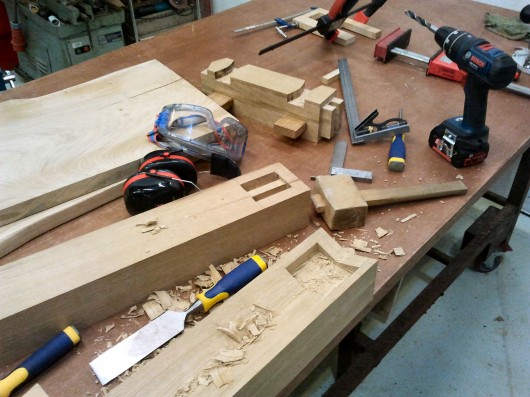
In all this beauty talk we are seeing with more than just the eyes. You see from your body – it’s all connected, stuff that feels good usually looks good. A chair that looks unstable and liable to collapse at any minute, isn’t often pleasing to view (unless we have tested it and convinced ourselves it is strong enough – then it might appeal because of its sensory baffling quirkiness). When we make a certain kind of joint in woodwork, we usually have some experiences with how that joint functions, and we will have built up knowledge of what makes a great joint, and what is less desirable.
So it’s understandable that when I look back over the photos of this particular project, it is some of the pics of the piece midway through construction, with the juicy joinery visible, that I find most appealing. For it is those, ultimately hidden, nerdy aspects of the work which evolve between you and the material. You cannot do whatever you want with wood – it’s not regular – plans necessarily evolve and change as the nature of the wood is revealed.
Making beautiful stuff
So back to Tage Frid’s original quote – does doing stuff reduce the beauty of wood? Obviously it depends on what you do. The process, and the way we make is a big part of it. It’s not a one size fits all. This piece had a good amount of very traditional joinery: mortice and tenons, but also some very unusual bits – slot in dovetail’esque slatted shelves with curvy natural edges, and routed butterfly joints made with the help of this (below) custom laser cut template.
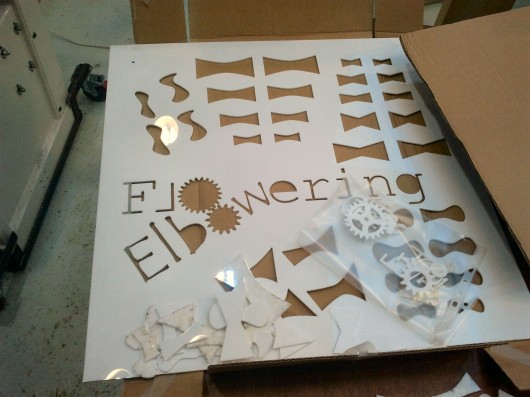
The butterfly inserts: some were used to reinforce natural splits in the wood, others to help visually tie together the angled mitre in the top…
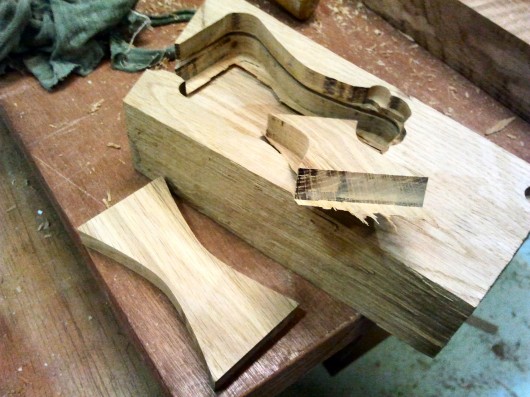
The dry test fits…
The dovetail slats for the upper shelf. Check out the awesome looking burr patterning in this Welsh oak…
In all this, it felt like it was in the process of working out which individual pieces of wood fit best for each application that little bits of beauty were discovered. Indeed the ‘that worked out well at last’ feeling was very much linked to the ‘oooh that looks good’ feeling. Or the sense of ‘that’s a damn solid joint’, leading to a lingering of the eye on that pleasing section, particularly if you managed to do the joint and still show what you consider to be the most exciting rays and grain in the wood.
Am I saying that to ‘get’ the beauty of an object you have to be a maker? No, not really. Just that making is one way in which you (quite literally) build a relationship with an object. Particularly if it is a one off commission, making can potentially enchant the otherwise inanimate. Another way of appreciating the beauty and making objects vibrant, is simply to live with, and respect them. I bet most of us have a trusty favourite this or that, which has come to be beautiful over the years regardless of its origins.
Anyway to return to the beginning: can, and should we do more than sand and oil? Or is the oft cited mantra: “let the wood speak for itself”, to be obeyed at all costs? Personally, loving what happens when you experiment with materials, I wouldn’t say wood should be filed away in the ‘simple and minimal is best’ mindset of making. Yes it can have amazing ‘natural’ beauty but the way we decide to display, use, and interact with that beautiful material has the potential to play about with our ideas of what beauty ‘is’ anyway. Our attitude and approach to making stuff with wood can involve a lot more than planing, sanding and oiling. Make it useful, make it strange, play with design, combine it with unexpected other materials, and most of all experiment. Think some crazy configuration or elaborate design could look good – try it! Or commission it ;) However it turns out the experience will help define what you consider to be beautiful in the future.
- [1] Frid, T. 1979 Joinery: Tools and Techniques, Taunton Press,Newtown Connecticut.↩
- [2]https://wiki.brown.edu/confluence/download/attachments/73535007/Phenomenology+of+Perception.pdf↩
| Tweet |
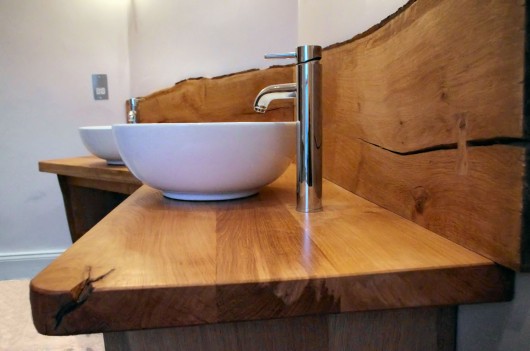
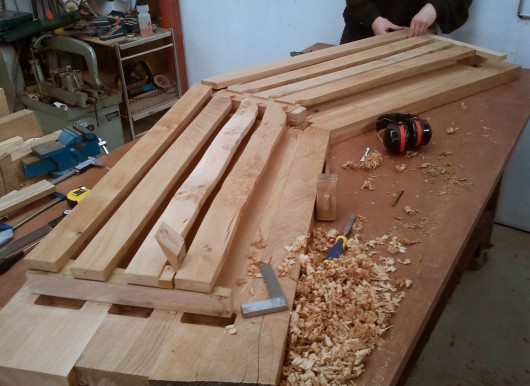
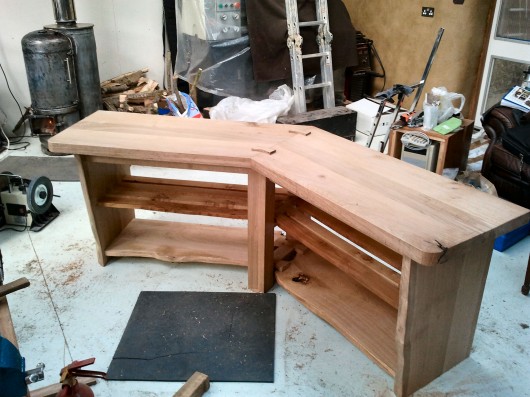
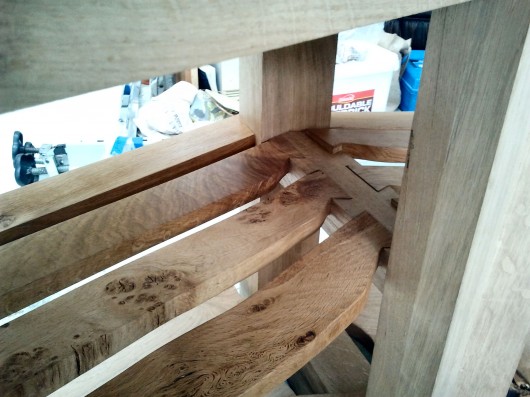
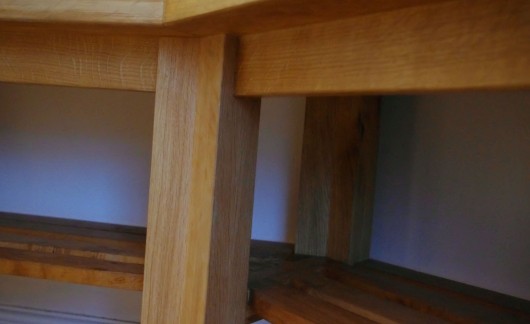
April 4th, 2013 at 8:47 pm
You made that? WOW is all I can say, stunning. My dad is a woodturner and in his inspirational moments (ie not churning out spurtles) feels like you say, that there is some sort of connection. One of his customers believes there a bit of his spirit in these items.
April 4th, 2013 at 10:39 pm
Hi Alyson,
Thanks for the comment :) Your dad’s plates are awesome! We’re still using them daily.
June 3rd, 2013 at 5:54 pm
I have not heard the label of “the interactionist perspective of beauty” before. The idea that the interaction engages the appreciation of beauty from the first or third person. I know that when I am creating something, I am it. I have this brief relationship with a material in which we converse. I listen to the grain or the ring the anvil to direct the flow of material. The piece creates itself through the medium of me. Maybe this is another way to understand the concept. Thanks
July 14th, 2014 at 2:53 pm
What an amazing piece of art and the way you translated your art into words! Arghh I wish I had a bit of a talent to create something so beautiful as ideas are endless..
Very impressive and well done, love your work:)